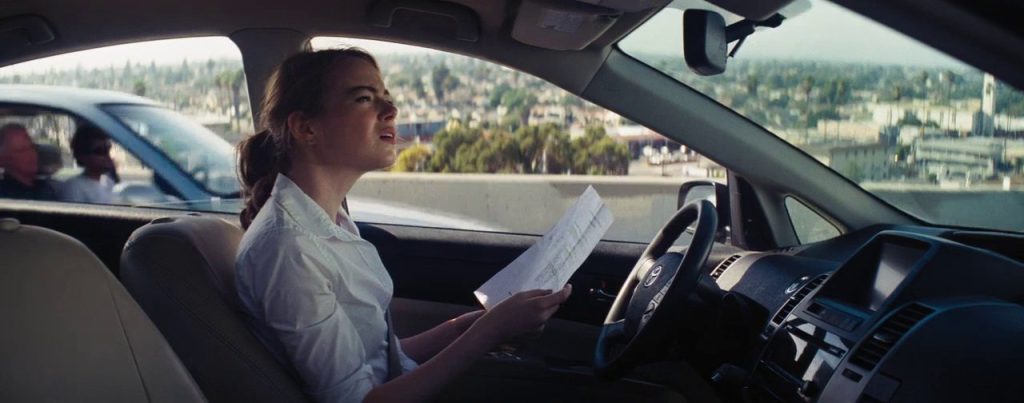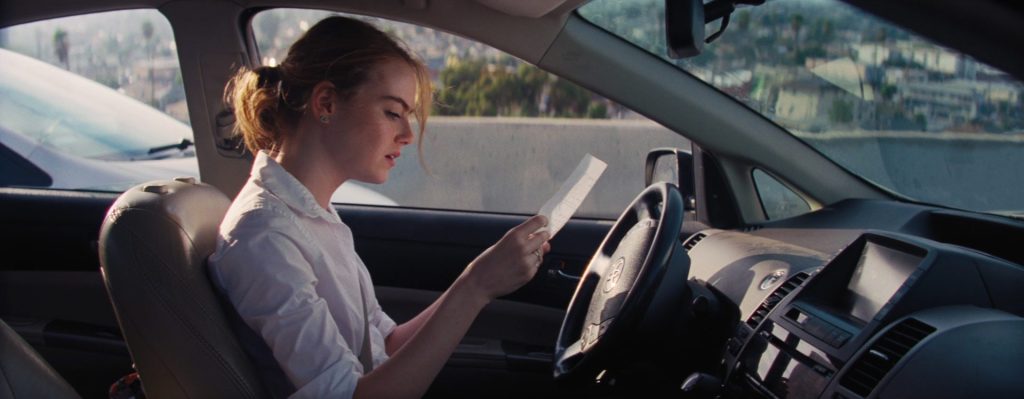Why Some Movies Can’t Give it a Rest

The picture above comes from the 2016 movie La La Land, which didn’t win Best Picture at the Academy Awards the next year despite being announced as such originally. But the Best Picture Oscar isn’t the only thing missing from La La Land. If you look carefully above, you might see it — or, more accurately not see it, because it isn’t there.
Here’s another picture from the same scene, in case that helps. But to be honest, neither image makes it very obvious.

Look behind Mia Dolan (played by Emma Stone), and you’ll not see it. What you will see is a clear shot of a car passing her through the back seat window. That’s because of what’s not there: her headrest.
Headrests — or, more accurately, “head restraints” — have been mandated by the U.S. National Highway Traffic Safety Administration for all new cars since 1969. (Here’s a picture of one if you don’t know what I’m talking about.) They exist to keep us safe — when a car is hit from behind, your body is pushed forward while your head lags behind for a split second. Without a headrest, your neck bends sharply backward and then forward — that sudden motion can overstretch or tear soft tissues in the neck, leading to whiplash. The head restraint shortens the length your head travels and can also help spread the force of the impact across a larger area, reducing or preventing that harm.
But if you’re making a movie, the odds of a car crash are very, very low — the roadways are in a controlled setting and, action films aside, there’s limited risk of any sort of such accident. The headrest serves no safety purpose but, unfortunately, leads to a lot of small problems when it comes to filmmaking. First, directors want a picturesque background behind their actors, as seen above — you’d rather see out the back of Dolan’s window than have an ugly beige headrest blocking the view. Second, if you have someone in the back seat, you often want to be able to see them. Take this clip from Harry Potter and the Chamber of Secrets, for example; one of the Weasley twins is driving a flying car while the other is in the back seat (with Ron riding in the front). When the camera shows us the interior of the car (here’s a low quality screenshot), we want to see Ron clearly; a headrest would have gotten in the way. Additionally, removing the headrest makes filming easier — it gives the cast and crew more room to maneuver in the car.
Most of us movie watchers never notice the missing headrest — why would we? — so we don’t even have to suspend disbelief. But now that you know, apologies if you can’t unsee what’s not there!
Bonus fact: Most head restraints, like the one not pictured in the scene from La La Land, are designed to be removable. The reason is for cleaning and maintenance — it’s easier to clean the seat if you remove the restraint, and it’s easier to clean the headrest once it’s removed. But the removability also serves another, unintended purpose. If you need to escape from you car, the metal bars that anchor many removable headrests can be used to break the glass of your window. (Here’s a video of this happening on a Japanese game show.) But that’s not by design. As Snopes reports, “while it is possible to break a car window with a removable headrest, this is an incidental application of that object rather than a deliberate one.”
From the Archives: The Time Travel Trap: How an auto parts dealer nabbed copycats, courtesy of Doc Brown. (By the way, the Back to the Future DeLorean? It still had its headrests.)
